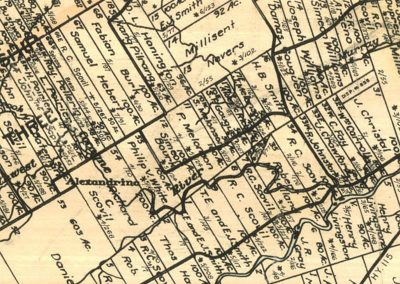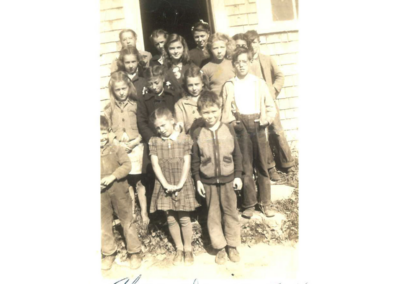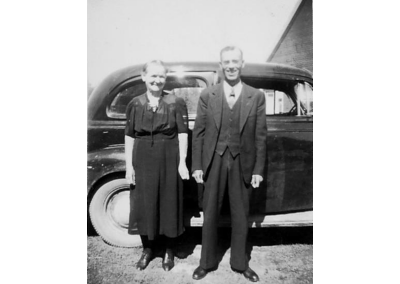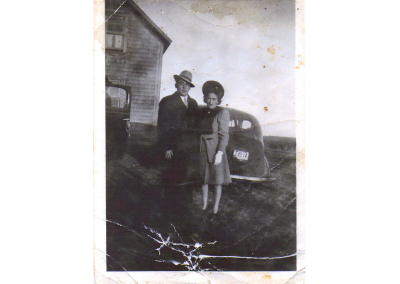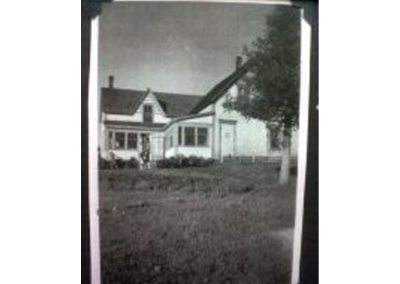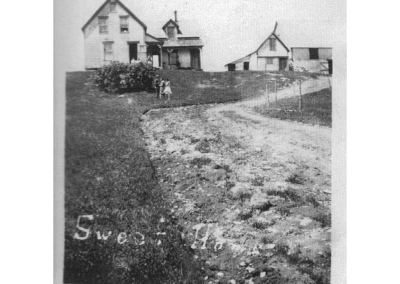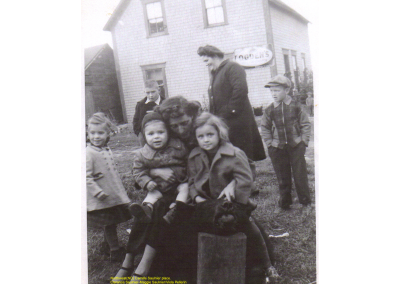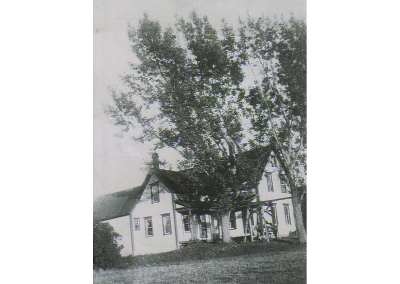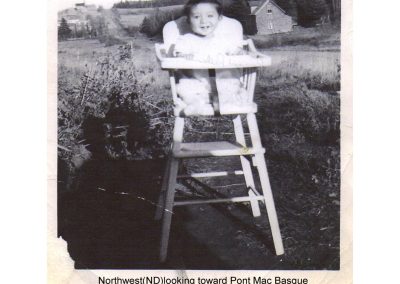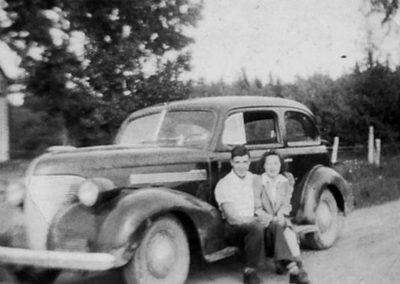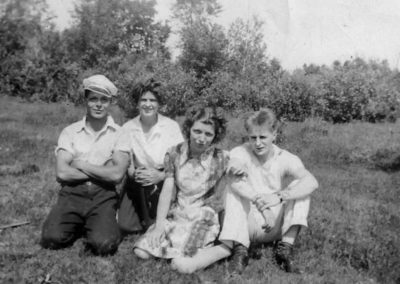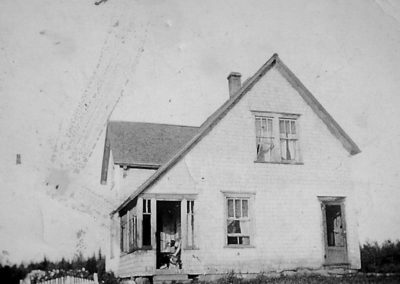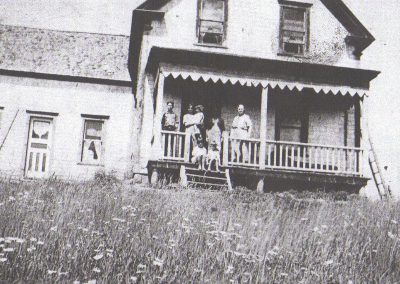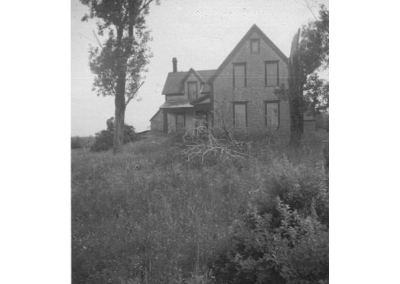Hays, Alexandrina – Nor’ouest
Three historical villages share borders and are located along the far end of the north side of the Cocagne River Road, crossing Grub Road and onward inland to Grady Road which leads to Poirier Office or branches off to Alexandrina and Nor’ouest”. This is a very sizeable area within a large forest.
The most eastern part of this area is Hays* is where settlers started arriving in the early 1820s. It spans from the1930s homestead of John and Mary Cuthbertson and westward to Alexandrina. At one point, Hays had a school.
Alexandrina was a beautiful village, intersected by the Nor’ouest branch of the Cocagne River. By the mid 1870s, it was well established and reputed for its appealing properties. Farms were described as pleasant to the eye and an indication of industry and activity. From here, one could travel to Sainte-Marie-de-Kent, passing through Village des Pellerin.
Alexandrina grew rapidly. By 1889, there was a post office. By 1940, electricity had widely been installed but did not reach every corner of the community. This proved to be a fatal blow to several settlements and the main reason why they were eventually abandoned. One of them was Alexandrina-Nor’ouest. Hays did not suffer the same fate. And today, this settlement is home to many houses and summer homes. Back roads are still accessible and reach Poirier Office, Saint-Antoine and Trafalgar. Today, Nor’ouest is well known for its exceptional ATV and snowmobile trails.
Note: Hays and Hayes were used interchangeably in historical documents. The use of spelling as Hays to describe a historical village in Notre-Dame is based on:
-
An 1861 census of Irish Immigrants shows Thomas Hays as being 53 years old and living in Dundas. He is believed to be the same Thomas Hays who owned land in ‘Hays’ in the 1830s.
-
Edward Hays is buried in the St Alban’s Anglican Cemetery in Cocagne, NB. He was 6 when he died in 1869.
-
A historical map, found in the New Brunswick Provincial archives and believed to be an 1830s portrait of land ownership in the area, shows a parcel of land owned by Thos. Hays. It was located down the road from Christopher Fay and J. Crawford. Neighbouring landowners were R.C. Scovil and Robert Dysart. The area was known as ‘Hays’.
-
The spelling ‘Hays’ is common in Ireland. Thousands of Irish were living in the province before the 1846 influx of immigrants due to the failed potato crops in Ireland. Many arrived in Saint John from Kinsale, Cork as early as 1815.
-
According to the Irish Canadian Cultural Association of New Brunswick, in 1820 … “many came from the Bally-na-muck area of the Parish of Morragh (Murragh today) in County Cork” and included the Hays family. Other early settlers of Hays include the Sullivans, Fays and Gradys.
Historic Photos
1800 to 1850
1824
It is believed that the Amos family settled in Hays Village in 1824 or earlier. Thomas Amos was born March 21, 1773, in Lowther Westmorland England and died in Bouctouche in 1831. He and his wife Jane had ten children, many of whom moved to Bouctouche. Daughter Elizabeth married Charles Teed and daughter Mary wed John Colborne around 1828. John became a Trustee of the Union Church when the title of the Church and Cemetery was transferred from Bowen and Harriett Smith who had long volunteered. Colborne died before 1861 and his wife Mary died in 1890. She is buried in St Albans Cemetery, Cocagne, NB.
It is uncertain but probable that the settlement of Hays was named in honour of Thomas Hays. A historical map shows that his land neighboured other landowners such as R.C. Scovil, Robert Dysart, and T.E. Smith. The 1861 Canada Census shows a Thomas Hays as being fifty-three years old and another as being twenty-eight years old, in addition to Edward Hays who died in 1869, and a third Thomas Hays shown as being two years old, all of them from Dundas, New Brunswick. Chances are they all belong to the same family.
The spelling of Hays and Hayes are often interchanged in historical documents.
Note: The name of Millicent Nevers appears on a historical map as an owner in Hays. We know that Alexander Nevers was born on February 4, 1787 in Maugerville, in Sunbury County, New Brunswick. He was the son of Samuel A. Nevers and Isabel Howard. Alexander married Frances Perley in November 1810, in Maugerville. The latter was the daughter of Israel Perley and Elizabeth Mooers. It is not known exactly what happened, but we do know that Alexander married his second wife, Millicent Peters, on March 18, 1814, in Grand Lake, Queens County, NB. Millicent was born on September 7, 1794, on Long Island, Queens County, New Brunswick. His parents were William Peters and Charlotte Haines. Alexander and Millicent had six children. The name Millicent Nevers appears on a historical map as the owner of land in Hays.
Alexander Nevers was the victim of a boating accident which cost him his life on October 11, 1833, in Shediac, Westmorland County (NB), at the age of forty-six. All six people on board drowned. He is buried in the cemetery of St. Martin’s in the Woods Anglican Church, Shediac, New Brunswick. Millicent died on June 8, 1861.
1826
Dundas was created from Wellington Parish, and it covered a large territory on the southern belt of Kent County. Communities such as Cocagne, Grande-Digue, Notre-Dame, Saint-Antoine, Goudalie, etc. were all part of the civil Parish of Dundas.
The Parish had a say in local governance and a responsibility to administer services such as schools. A local committee hired teachers, maintained the school infrastructure and grounds in good order, etc. As local schools were built, the district assigned them a number. For example, the district of Guéguen was designated as District Dundas 4.
Early 1830s
John Kairns (Cairns), John Christal, John Colborne, John and Daniel Crawford settled in Hays. Crawford genealogy records indicate that Daniel was married to Mary Abigail Marr and they had two sons, Jacob and William. Daniel died in 1861 and is buried in St Alban Cemetery, Cocagne, New Brunswick.
1844
Land in Alexandrina was granted to Christopher Fay. It remains in the family to this day.
1851 to 1875
1853
Josiah Crawford settled as one of the first inhabitants of Hays Village, which was an area on the north side of the Cocagne River, which borders Alexandrina to the west. On December 12, 1853, he was granted 50 acres of land which ran to the river and next door to Robert Johnston’s home.
It is believed that Josiah was Daniel Crawford’s father. Daniel was married to Mary A. Crawford, and he died in 1861. They had two sons, Joachomish (Jacob) and William H.
Jacob was born in Pugwash, Nova Scotia. On November 9, 1868, he married Henrietta Ann Gray (born 1849). He was a blacksmith, and his religious affiliation was Episcopal. They lived near the Teed family on Teed Road, and he died March 17, 1908.
William H. Crawford married Mary Abegail Marr and their son William John was born in 1871. His brother Jacob lived next door to each other. Another son, Elisha A. Crawford was born in 1864 and died in 1927. His descendants (family) donated a pump organ to the Union Church in 1985.
Samuel Wesley Teed and his wife Annie (Stuart) Teed lived nearby. Samuel was born April 24, 1888, to parents Thomas and Alice (Donnelly) Teed. Annie was born in 1892 to parents Edward Stuart and Katherine (McNeil) Stuart of Scotch Settlement. They were married in Moncton on October 27, 1920, and moved to Notre-Dame near the family homestead until 1934 when they moved to the Stuart homestead in Scotch Settlement. They had three children. Wesley was the son of Thomas and Alice (Donnelly) Teed and Annie was the daughter of Edward Stuart and Katherine (McNeil) Stuart of Scotch Settlement.
Note: Thomas Teed (1838-1907) met and married Alice Donnelly (1848-1928) in Saint-John, New Brunswick and most of their children were born there except for three who were born either in Notre-Dame or Shediac River. They moved to Notre-Dame sometime between 1881 and 1891, moving from Thomas’s father’s property in Shediac River. Their son, William J., was born in 1886 and married Emma B. Cobham (born in Saint-John in 1889) on October 15, 1906. Emma lived with William James Cobham and Emily Jane (Johnston) Cobham – presumed adopted as census shows her as their daughter. William died of consumption at 22 on March 22, 1908. They had one child, Atkin C. Teed, born in 1907 and he also died of tuberculosis at the age of 22.
In 1920, Samuel Wesley, son of Thomas and Alice (Donnelly) Teed, married Annie in Moncton. They moved and lived near the family homes.
1856
William Carroll and Christopher Fay were early settlers of Hays. They were both granted land on April 21, 1856. Their neighbours were the Crawfords, Johnstons, and Christals. Carroll’s daughter, Margaret Johannah Carroll, was born in Dundas in 1856. William was thirty-nine and Catherine was thirty-six. Margaret married John William Atkinson on December 23, 1879, in Moncton and they had nine children. She died in 1896 at the age of forty and is buried in the St Alban’s Anglican Cemetery in Cocagne.
Christopher Fay was born circa 1795 in Dublin, Ireland. He married Catherine Smith (born 1800) on June 20, 1819, at Parishes of Donnymore and Killbride, Co. Meath, Ireland. Their daughter Catherine was six years old, and their son James was two years old when the family migrated to New Brunswick in August 1826. Other children were John (1828), Michael (1830), Mary Ann Fay (1833), Margaret Fay (1836), Jane (1837), and Elisabeth (1840). Christopher (died March 1849), in Kent County, NB. He was also known as Christian Fay.
The 1851 Canada Census shows Catherine Fay (Fea) as being fifty-six years old, a widow, Irish, farmer, entered Canada August 1826 (same date as daughter Catherine).
1861
A census showed Thomas Hays (age fifty-three) as living in Dundas. Also shown were Catherine Dysart (age fifty-four), Robert Dysart (age sixty), Ann Johnston (fifty-eight) and Elizabeth Johnston (sixty-one).
Abt 1875
Alexandrina was settled by Damien Babineau, Pierre S. Melanson, Aimé P. LeBlanc (blacksmith), Philippe Goguen, Mélème Saulnier, Jude A. Bourgeois, Jos P. Bourque, Abraham Goguen (postmaster), Albénie Bourgeois, Thomas Bourgeois, François J. Goguen and M. Surette.
An undated historical map shows land in Nor’ouest as belonging to Philippe LeBlanc, Simon Bourque, P. Melanson, Ray Pellerin, H. Poirier, Samuel Hébert, Fabien Bourque, Marie Pellerin, J.T. Bourgeois, Fabien Hébert, and Jude Hébert.
1876 to 1890
1885 to 1956
A post office operated in Alexandrina. First postmaster was T. Stephenson and the last was Raymond Pellerin.
1900
One-half ton of hay cost $3.50, one bushel grass seed $2.50, one pair of shoes $1.10, five locks and nobs $1.50, one bottle of Mother Seigel $0.30, one hundred lbs of flour $5, three lbs of tea $1.20, one gallon of oil $0.25, and one bottle of liniment $0.35 according to a record of household affairs.
1901 to 1925
1901
The Catholic Church was officially named Notre-Dame-du-Sacré-Coeur and the parish subsequently defined the territory of the community of Notre-Dame. The settlements (or historical villages) included were MacDougall Settlement, Poirier Office, LeBlancville, Dufourville, Notre-Dame Centre, Guéguen, Hays, Alexandrina (Nor’ouest), North and South sides of the river, Whites Settlement along with Village des Pishcots, Village des Fricots, Suretteville, Teed Road and Chemin des Thaddées.
1901
On March 22, 1901, a powerful frechette destroyed three covered bridges: the Lockhart Bridge, the Poirier Bridge and the McLaughlin Bridge. It is believed that all three bridges have been rebuilt.
1901
On June 29, 1901, a bridge was sold to John Colborne for $20. Bridge No. 2 over Alexandrina Creek (Northwest) was sold to Maxime Robichaud for the sum of $13.50. The two Poirier Office decks were sold to Thomas Poirier, one for $12 and the other for $20.
1904
Alexandrina was described as being a farming and lumbering settlement with a population of 50.
Note: In the 1900s, schoolteachers were hired by local parent committees. Teachers lived “room and board” in the vicinity of the school. Inspectors were hired by Dundas Parish administrators who regularly visited school and wrote detailed reports which were influential and brought about change.
1909
On August 31st, Notre-Dame-du-Sacré-Coeur became the patron of the Notre-Dame Catholic Church which was blessed by Mgr Thimothy Casey of Saint-John.
1925 to 1950
1932
A few people had electricity as early as 1932 and by 1940, service was widespread but did not reach every corner of the village. This proved to be a fatal blow to several settlements and the main reason why these areas were abandoned, such as Alexandrina-Nor’ouest, chemin des Thaddées, Village des Pishcots, Village des Fricots, and Suretteville.
1935
A suspension bridge was constructed by Mac Basque, Patrice Pellerin, and Thaddée Pellerin over the river at Hays, a short cut to the church, school, post office, etc. It was known as “pont macbasque”. Unfortunately, one and a half years later, ice brought down the handy suspension bridge.
1951 to 2000
1954/56
A home postal delivery service was introduced in Notre-Dame. Mail was delivered by drivers who would insert letters and parcels in mailboxes next to the road of each house and business throughout the community. One route started at the Notre-Dame Post Office then onward to Hays, Alexandrina, across the covered bridges to Poirier Office, LeBlancville, Dufourville and ending where the route began, at the post office. Delivery areas grew to include Guéguen, the South side of the river road. The MacDougall Settlement mail delivery was and remains part of a different route.
With the arrival of mailboxes and home postal delivery, several small post offices were closed, such as Dufourville, LeBlancville, Alexandrina, Poirier Office, and MacDougall Settlement.
Postal delivery was first done and for many years by Joe Delaney, followed by Thomas Robichaud, M. Delaney, Olivier Bourque, Alcide Pellerin, Frank Maillet, Regis Bourque, and others.
1958
Notre-Dame was made up of 7 different school districts: Upper Guéguen, Hays, Alexandrina, LeBlancville, Dufourville, MacDougall Settlement and Notre-Dame. A few years back, the Whites Settlement district had joined Cocagne. The school board was responsible for school maintenance and repair as well as for the hiring of teachers, heating, and other expenses, paid for by local taxes.
1959
On January 14, 1959, the two-room wooden schoolhouse École de Dundas was destroyed by fire. Classes are held in the parish hall and in the church basement. Ten short months later, a new two storey brick school was officially opened on November 14. L’École Centrale de Notre-Dame continues to cater to francophone students from the four corners of the community. Today, it is known as École Notre-Dame. First principal was Roméo Robichaud, followed by Gérald Aucoin who remained for many years. President of the School Board was Ernest Gallant.
1959
The school at Hays closed. Little information is known.
2000
In March, the postal addresses were changed from site and box number to civic numbers thereby improving efficiently and visibility, especially for emergency services such as fire and balance services.

